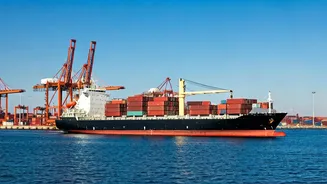Sanctions' Impact Unveiled
Recent US sanctions targeting Russian oil majors have triggered a cascade of effects across the Indian oil market. These sanctions, specifically aimed
at shipping, insurance, and trading networks involved in the supply of Russian crude, have created an environment of uncertainty. The outcome is a tighter supply chain, reduced discounts, and increased transaction risks. Before the sanctions, India benefitted from discounts of $8–$12 per barrel over Middle Eastern benchmarks, along with flexible payment arrangements. However, these advantages have diminished significantly. This led to a shift in sourcing patterns, compelling refiners to seek alternative suppliers and adjust their operational strategies.
Refiners' Strategic Pivot
In response to the changing landscape, Indian refiners are actively diversifying their sourcing strategies. Reliance Industries has ceased new purchases linked to Rosneft, opting for spot-market cargoes. Similarly, Indian Oil Corporation has paused fresh contracts with Russian suppliers. Bharat Petroleum and Mangalore Refinery are increasing their imports from the US and the Gulf region. This shift is also evident in the import data, as Russian oil's share in India’s import basket has fallen to roughly 34% this fiscal year, compared to about 36% in the prior two years. Simultaneously, import costs have risen by approximately $5 per barrel higher than the Dubai-linked averages. US crude imports into India soared to about 575,000 barrels per day in October, the highest since 2022, signaling a clear pivot away from the Russian supply.
Economic Ramifications Emerging
The economic implications of these shifts are not negligible. Elevated crude prices could expand the fiscal deficit and strain the import bill, according to market analysts. The operational impact is already visible; crude processing in September fell to its lowest level in nearly 19 months. While maintenance shutdowns are cited as one reason, refiners privately admit the flexibility once provided by cheaper Russian crude is lessening, mandating tighter planning of run rates and margins. Experts predict India will need to broaden its supplier base, seek gains in domestic production, and utilize strategic petroleum reserves more actively to manage the volatility. The question now becomes how the cost burden will be distributed.
Adjusting to the Reality
The current situation presents significant challenges for Indian refiners. Companies like Nayara Energy, with Rosneft influence, face heightened constraints due to limited viable substitutes in the short term. The ability of oil marketing companies to absorb higher input costs is finite. For the moment, pump prices remain unchanged. However, the dynamics are shifting, and unless global crude prices soften, price adjustments impacting consumers are likely when the political climate allows. The shift away from discounted Russian crude represents a strategic recalibration for India, with the potential to influence refinery run rates, import costs, and procurement strategies across the sector. This adjustment period requires the industry to navigate a more complex and potentially more expensive operational cycle.















